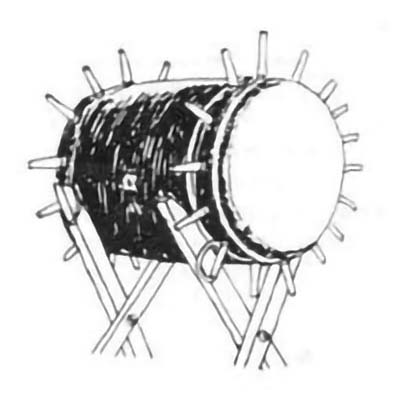The production process of spit
115 views · Organized by 夏浩东 on 2022-02-10
The Jino people have stricter customs in making stuffed spit. It is necessary to enter the mountain to select materials first. Those with broken tree tips and branches cannot be selected. After the trees are selected, they will be cut down on an auspicious day.
The tree felling was carried out at night, and a rooster had to be killed to pay homage to the spirit of the tree. During the felling, women or any animals were not allowed to see it. After the tree fell, the drum was chiseled and carried back to the village. Women had to avoid it.
The skin of the covered drum is the most particular. The sun during the day, the moon at night, and the lights cannot be covered. The most taboo is that these lights reflect the shadow of the covered drummer into the drum shell and lock the soul inside the drum, so the best time to cover the drum is. It is the morning when the stars have just set before the sun has risen.
Before the skin is covered, the elders should recite prayers and kill the chickens for worship. After the hood is covered, bamboo-woven cows, sheep, chickens and ducks are hung on the wooden awns of the drum to simulate poultry. After the elders sing and beat the first big drum, the spit will sound together with the cymbals and cymbals, and the new drum will be in the village. Hanging in the drum room of the house, the seventh elders of the village council kneel to offer sacrifices to the big drums, entertain the elders of the whole village, and announce the birth of Xinsai Tu.
The tree felling was carried out at night, and a rooster had to be killed to pay homage to the spirit of the tree. During the felling, women or any animals were not allowed to see it. After the tree fell, the drum was chiseled and carried back to the village. Women had to avoid it.

The skin of the covered drum is the most particular. The sun during the day, the moon at night, and the lights cannot be covered. The most taboo is that these lights reflect the shadow of the covered drummer into the drum shell and lock the soul inside the drum, so the best time to cover the drum is. It is the morning when the stars have just set before the sun has risen.
Before the skin is covered, the elders should recite prayers and kill the chickens for worship. After the hood is covered, bamboo-woven cows, sheep, chickens and ducks are hung on the wooden awns of the drum to simulate poultry. After the elders sing and beat the first big drum, the spit will sound together with the cymbals and cymbals, and the new drum will be in the village. Hanging in the drum room of the house, the seventh elders of the village council kneel to offer sacrifices to the big drums, entertain the elders of the whole village, and announce the birth of Xinsai Tu.
Involving musical instruments
Saitu (pinyin: Sāi tǔ) is a musical instrument unique to the Jino people. It is made by hollowing out a piece of red hair tree log, and it is cylindrical. Specifications vary. Both ends of the drum frame are covered with untreated hairy yellow cowhide, the diameter of the drum surface is 40 cm to 80 cm, the height of the drum frame is 70 cm to 120 cm, and the thickness of the drum wall is 3 cm to 5 cm. Twelve or sixteen square wooden sticks hold the drumhead around its edges. The wooden stick is 30 cm long, thick at the top and thin at the bottom, and the thickest part is 4 cm square.
Guess you like
Organized by 向日葵 on 2022-02-10
There is a legend among the Jinuo people: in ancient times, the world was chaotic and vast.
read >>
 渝公网安备 50010702504639号
渝公网安备 50010702504639号